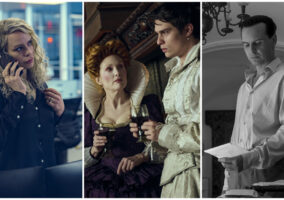Onwards. Part one of this episode’s Mad Style is here and our initial episode review is here.

Once again, Sally stands out in a scene. In the living room, she was the only one in a brilliant blue, while the other women wore pink, red, or white. Here, she’s a focus-pulling red against the greens of the kitchen and the blues of her mother. Given her eye-rolling sarcasm in the few lines of dialogue she had, we think we’re seeing some visual representation of her oppositional attitude.
Is it awful that every time we look at that kitchen, all we want is for the Kitchen Cousins to show up and shove some stainless steel appliances and a tiled backsplash into it?
Betty is, of course, the height of ’60s housewife frumpery. Six years ago, this is what she looked like when she went grocery shopping:
That sense of glamour and looking just-so (which was, to be fair, a middle and upper-middle class pretension of the period) has evaporated. This isn’t to say Betty looks like crap in 1967; just that she clearly didn’t spend the entire morning getting dressed to go shopping. And to be fair, part of this change is due more to Betty and the change in her circumstances rather than the change in the times. She was much more glamorous when she was married to Don, in large part because he was making more money, she had one fewer children, she was half a decade younger, and he was pretty glamorous himself, in comparison to Henry. This is Janie Bryant using a character’s personal history as well as the changing times to make a point about her in her clothing.

We said something in the comments section the other day that we want to repeat here. Whenever we look at older characters in the show, we immediately try to figure out when they were born. It’s shocking, for instance, to find out that Miss Blankenship lived on a farm in the 1800s. So we look at these women and realize that they remember the First World War (well, in fact, since they would have been adults at the time) and were not allowed to vote until it was granted to them. They are, in effect, the American versions of the Crawley sisters on Downton Abbey.
So it’s perhaps not a surprise that they all look like (only slightly) updated versions of the Dowager Countess. The loudmouth in the wheelchair is wearing styles that mostly went out of style at least 50 years before.
The rest of the scene – aside from the Drunk Don parts – was all about highlighting those generational differences among the women.

First, there’s Jane, who breezes into the room spewing modernity and fabulousness in all directions. Gorgeous outfit.
There’s not much to say when everyone in the room is dressed in conservative black ensembles, but once again. Janie found ways to delineate the women from each other. There’s Jane vs. the old biddys…

And then there’s Mona, who is rather stylishly well-appointed in a mature way, giving off a sense of solidness and even tradition; a polite, mannered counterpoint to Roger’s histrionics as well as Jane’s mod mourning getup.

As for Margaret, she is, and always has been an exact clone of her mother, right down to the hairstyles.

Little, perfect, Betty Hofstadt, arguing with dirty squatters in a rat-infested building. As we said earlier, you can’t really come up with a better way to depict how much society felt like it was in decline to the older generation.
Just as all the intense, eye-popping colors of the Hawaiian interlude indicated heat, so do the greys and blues of this scene indicate cold to us.
This is an illustration of how the way a costume works in a scene can change from scene to scene. This exact outfit looked frumpy and mature when she was standing in the kitchen talking to Sally. And while it still comes across mature here, it looks utterly refined and expensive on her now; especially in juxtaposition with the squatters, the blues suddenly standing out in her scarf and skirt. She’s uncomfortable in that setting not just because it’s potentially dangerous, but because her upper-middle class life is laid out on the table for all of them to ridicule.
The creators of Mad Men will often very subtly refer to film and television styles of the period. For instance, the scenes with Megan’s parents last season were shot and staged like a typical French divorce drama of the period. Betty in Rome referenced Italian neo-realist films. The Christmas Party in the office looked very much like it could have been a scene in “How to Succeed in Business Without Really Trying.” Don’s birthday party last season had the flat lighting and laughing background characters of a wacky ’60s sitcom. We said at the time that it looked like the kind of party The Monkees would wind up crashing. Anyway, we’re rambling, but this entire scene reminded us of a whole string of late ’60s/early ’70s TV movies about how the dirty awful counterculture encroached on suburbia. Endless stories of teenage prostitutes and drug addicts with patient, well-appointed upper-middle class white parents trying desperately to save them from a life of crime or worse, non-conformity. So basically, Betty’s standing in for Hope Lange or Eva Marie Saint or Shirley Jones (or some other blonde WASP mom-actress of the period) in some ABC Movie of the Week about a wealthy mother searching for her runaway violinist daughter on the filthy streets of New York.

Another example of a costume doing yeoman’s work from scene to scene. When Peggy was on the phone with the pastor while wearing this outfit, it was all about her Catholic schoolgirl background. When you put her in a scene with her Zappa-faced boyfriend, who expresses some discomfort with her management style, you can see that these characters are going in different directions. When you have her berating a couple of nerdy, baby-faced copywriters, she comes across well-appointed and confident; even mature in comparison to them.

Adorable, slightly slimy Bob Benson is going to be a bit of a problem, isn’t he? In his earlier scene with Don, we noted how his youthful, college-grad career man clothes stood in sharp contrast to Don’s mid-Century mature blackness. Bob is a Don stand-in, even though he’s accounts. He resembles him to the point that he could pass for a younger brother and he’s got the same kind of 3-syllable alliterative name. Plus, Don got his first job at SC by essentially berating Roger on an elevator.
But here, he now stands in opposition to Ken, who’s probably not that much older than him but is far more settled in his career. Bob is once again wearing the blazer and khakis (as opposed to a suit) that indicates his youthfulness, but Ken is suddenly looking very settled and authoritarian, with his expensive-looking coat, scarf, and briefcase. Ken’s normally depicted coat-, hat-, and briefcase-free; a happy-go-lucky dreamer who refuses to make this world his whole life. But here he looks like he’s moved up the corporate ladder. SCDP is now handling Dow, which means serious bucks for the company and serious career advancement for Ken, whose father-in-law works for them. He refused a partnership and he can’t be made head of accounts while Pete’s still breathing, so we assume he must have gotten a serious raise. It’s not like Ken to do what he did in this scene; dress down an employee in front of other employees. He’s pure establishment now; fully entrenched in this world he used to be so ambivalent about, and willing to fight someone when he feels they’re not acting correctly.
Also: note how the hair product has mostly disappeared from the heads of the younger men. Ken used to have very lacquered Vitalis hair, as did Harry and Pete.

We don’t think the men in this scene have much to say, costume-wise. Except for Stan and Don, of course. The rest of the men are in grey, brown or black, but Don and Stan are pushing green and blue into the conversation (like the green and blue motif in Peggy’s conference room scenes). Stan looks insanely out of place in this setting, but no one in the room is batting an eye at him. Remember what Sal looked like 6 years ago in client meetings?
Don is in an unusual-for-him shade of blue, which of course matches the blue jacket in the ad.

Even in a setting as conservative and traditional as this, Janie Bryant made sure that the scene was loaded with pattern and color. Henry was initially presented as a romantic, sexual figure when he first came on the scene. Remember when he met with Betty for coffee to discuss some watertower or reservoir or something? Remember how charged that scene was with sex? We thought he was slowly being turned into a slightly less romantic figure over time, but this ridiculous sweater seals the deal. He’s solid and loving, but he’s boring, conservative and a little dorky (like a lot of people in politics). We’d argue he’s probably the best thing that’s happened to Betty, but that doesn’t necessarily mean it’ll last or that she’ll be able to be happy with him in the long run. Then again, she’s chronically unhappy.
Anyway, here he is, looking like the squarest of the square dads. Nothing else much notable about the family, except there’s a through-line of red tones running through their outfits, in preparation for this:

It sucks that these posts take so long, because we wanted to be the first ones to shout “MAMA FRANCIS! MAMA FRANCIS!” But alas, most of the rest of the internet got to it before we did. Yes, she’s serving up full Mother Francis drag here, and the sad part is, she has absolutely no idea. That deep wine red is not a very typical Betty color, but Mother Francis wore a dark red to the Nutcracker earlier, under her fur. We think it’s a color she favors, but we don’t have the time to do the research and we seem to remember her in a lot of blues. Either way, this is quite obviously not the Elizabeth Taylor of Henry’s polite compliments. This is what Elizabeth Taylor looked like at the time. We wonder if Henry sees it. How can he not? Then again, denial is a powerful thing.


Later, they all put their keys in a bowl and …
Don is grooving out in his middle-aged man’s respectable blazer. This looks wild to us now, but it’s not something the young were wearing at the time. We said this when he dressed similarly for his birthday party: he looks like a Seagram’s ad running in Esquire. The well-appointed male.
Megan is wearing the latest in late ’60s loungewear-as-hostess-wear, which was quite the trend well into the seventies and speaks to her youth in relation to the other women. She and Don are in matching tones of grey. Sylvia is once again wearing black with white accents and a big gold cross; once again reminding us of a sexy nun. Her husband is dressed to match her.
The drunker couple with the flirting wife were full of color, but not particular giving off a united front with their clothing. She’s wearing the eastern-inspired styles that came out of the Beatles’ flirtation with the maharishi and the way it trickled down to … pretty much everywhere, really. She and Megan both have metallic elements at the neckline, in competing golds and silvers. “Back off my man, bitch.”
Tom’s parents had that exact fondue pot, in ’70s burnt orange. He never remembers them using it.

We don’t have much to say on the costuming because he’s in a standard tuxedo and she’s in her coat. The differences speak to the power dynamic here, since he’s her boss. It’s notable that Peggy now seems to have several fairly nice-looking coats, which speaks to her income level now. Once again, she’s wearing a plaid scarf slung around the neck, Don-style.
We have to ask, though: Are we the only ones who thought this scene had a lot of romantic undertones to it? We don’t actually want to see Peggy have a relationship with her married boss because it would be such a stupid thing to do, especially since her Pete and Duck work-related relationships were both disastrous. But look at him in these pictures. He’s in love with her.

Their costumes are having a conversation with each other. They are both wearing exactly the same colors (dark grey, light grey, white, and red), dark-over-light vs. light-over dark (think about THAT), each with a bit of pattern peeking out. Unlike, say, Betty and Mother Francis, we don’t think these subtle similarities speak to a similarity in the two men. They couldn’t be more different from each other. Instead, it hints at the bond they have, even if only one of them knows they have it.

Like so.
We do think the symbolism of the heart, the crucifix, and the mother figure were way too much, though. Come on, Weiner. We get it.
[Stills: tomandlorenzo.com]
Mad Style: The Doorway, Part 1 Next Post:
Mad Men: The Collaborators
Please review our Community Guidelines before posting a comment. Thank you!




